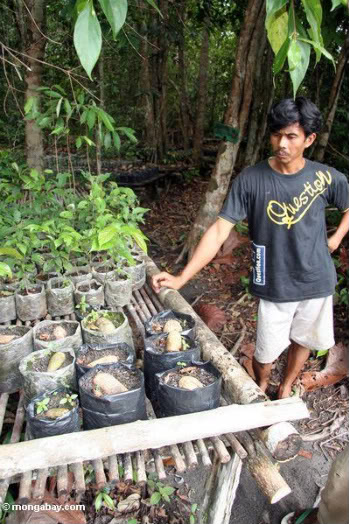|
|
Scientists argue that reforestation in the tropics is key to combating climate change
At the Smithsonian symposium entitled “Will the Rainforests Survive?”, leading tropical biologists vigorously debated current threats to the rainforest and what the future may hold. While climate change was identified as a leading threat to rainforests, many of the scientists argued that the tropics may also be the key to mitigating the impact of global warming.
The scientists overwhelmingly supported initiatives such as REDD, which would pay tropical nations to preserve their rainforests due to their ability to store and lock carbon. However, a number of the speakers recommended a further initiative to combat global warming: reforestation in tropical regions.
 A reforestation project in Tanjung Puting National Park in Borneo. |
Joseph Wright, a staff scientist at the Smithsonian, told the audience that “we are going to reach a crisis point with global climate change and the solution is going to be in the tropics”.
Tropical forests act as one of the world’s largest carbon sinks, yet have been lost at high rates due to agriculture, logging, mining, and pasture land for grazing. It is estimated that tropical deforestation amounts to 15 percent of the world’s annual carbon emissions, a share greater than the transportation sector. However, scientists believe that with large reforestation projects, the tropics could begin a new cycle of absorbing excess carbon.
“I only know one way to pull [carbon] out quickly” from the atmosphere, Wright said, “and that’s biology … [through] reforestation”. Wright urged that society begin a radical new initiative of “re-engineering the planet with ecosystems to pull out as much carbon as one can”.
Addressing an audience composed primarily of American citizens – historically the world’s leading nation in carbon emissions and still the leading emitter per capita – Wright said starkly: “we are the ones who are responsible” and therefore must do far more to address climate change.
Robin Chazdon, a professor of ecology and evolutionary biology at the University of Connecticut, agreed, telling the audience that society should be open to the idea that “new” forests can be managed to “help mitigate climate change and help biodiversity”.
Chazdon has worked with secondary growth forests—those forests in the process of regrowth after being used for agriculture or logging—for over eighteen years. In her talk, she urged conservation initiatives to pay attention to secondary growth forests and other human-modified landscapes.
“We can be engineers [by] building new ecosystems or at least giving them a start”, she explained.
Chazdon’s remarks were based on years of research in which she and other scientists have discovered that tropical forests can bounce back after degradation quicker than expected. Some trees in reforested areas have reached 20 meters in just 20 years.
Reforestation is already happening naturally across the tropics – according to Gregory Asner of the Carnegie Institution’s Department of Global Ecology at Stanford University two percent of the world’s tropics are now in some stage of regrowth – but the percentage could be raised through “a lot more engineering in the landscape” says Chazdon.
While forest recovery offers hope the current trend for the tropics is still predominantly one of deforestation, which further contributes to warming rather than mitigation.
“If ever we are to emerge from the bottleneck [of global warming] it’ll be through the re-emergence of the tropics,” Wright concluded.
Previous articles
Reforestation can be beneficial – or detrimental – it depends on the details
(06/12/2008)
In a ‘perspective’ piece published in the journal Science, Dr. Robin Chazdon argues that the complexities involved in reforestation initiatives require a case-by-case analysis to determine whether natural regeneration or some form of human-guided reforestation is the best way to proceed. Considering the growing interest in reforestation, Chazdon believes it is best if done effectively, positing the question: “At what position along a forest degradation gradient does ‘accelerating succession’ through planting trees achieve faster recovery of forest structure and composition compared with unassisted regeneration? This question is challenging to address.”